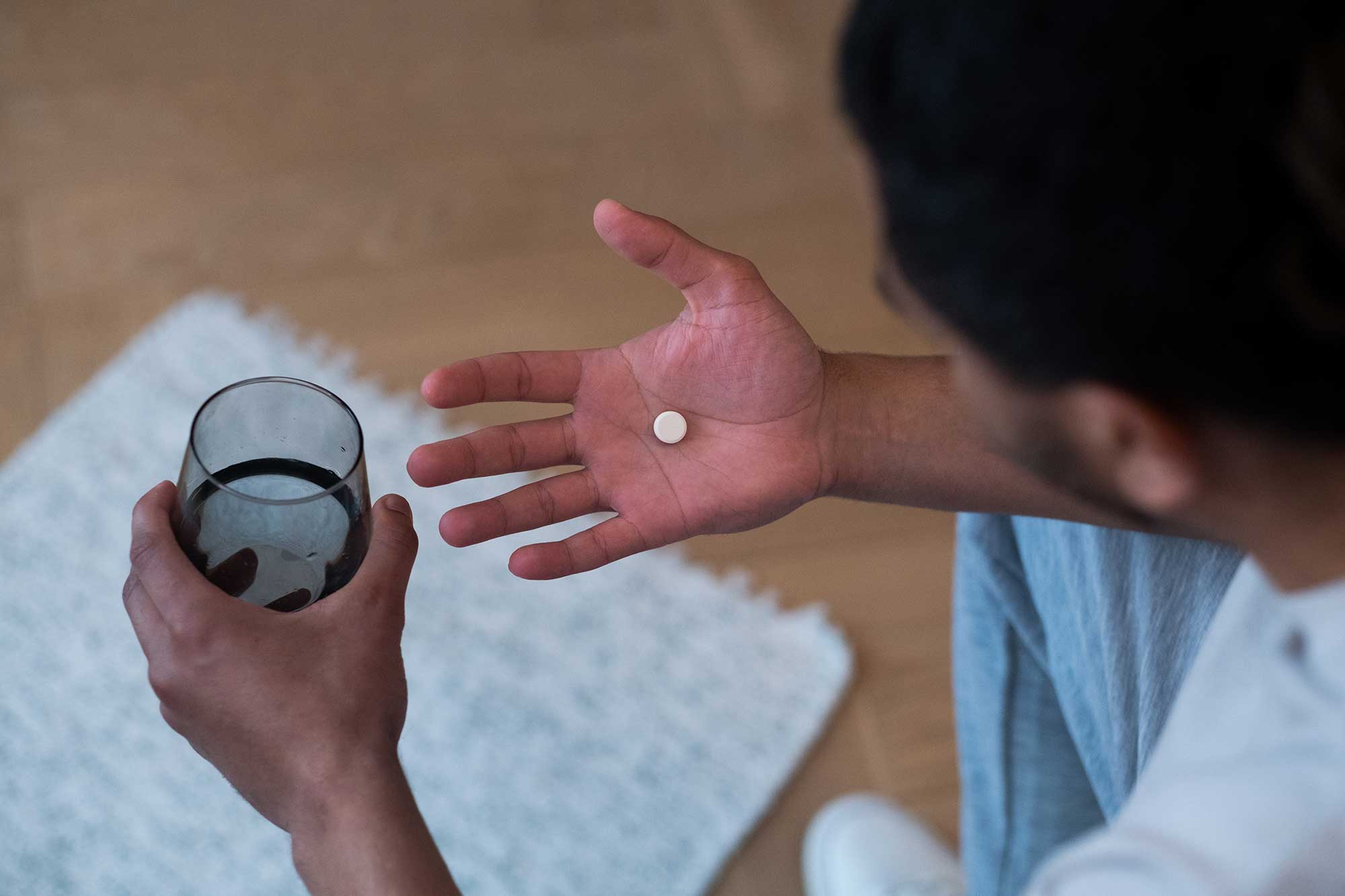
If you are suffering from alcoholism, also known as alcohol use disorder (AUD), you don’t have to struggle through the severe effects of withdrawal to achieve your goal of sobriety. Instead, you can find freedom through a medication-assisted treatment (MAT) program.
According to Oxford Languages, the phrase “cold turkey” means “the abrupt and complete cessation of taking a drug to which one is addicted.” Furthermore, “cold turkey, with no medication, is not recommended for those with medical conditions.”
Thankfully, with the help of an MAT program, you won’t have to worry.
Medication for Alcoholism
After years of research by doctors and health care professionals, there are now options to help treat alcohol use disorder (AUD). According to several studies, medications seem to be an important part of the most effective combination for treating AUD, though they are still underused for treating alcoholism.
The studies found that individuals receiving any medication did much better than those who didn’t receive any medication at all.
Considering that less than 1% of those getting help for alcoholism receive a prescription medication, it is clear that it is underused. Medication can offer people an advantage for their recovery. This is especially true in a “real-world” setting.
Medications Used in Treating Alcohol Use Disorder
- Disulfiram (Antabuse)
- Naltrexone (Vivitrol, Revia, or Depade)
- Acamprosate (Campral)
- Topiramate (Topamax)
- Ondansetron (Zofran)
The COMBINE Study
The Combining Medications and Behavioral Interventions for Alcohol Dependence study, published in 2006, followed more than 1,300 participants over a three-year period to discover what combination of treatment, medication, and counseling was the most effective for treating AUD.
The study revealed that one of the newer medications used for treating alcoholism did not improve treatment results on its own. The COMBINE study showed that no single medication or treatment approach was effective for every person or in every case.
However, after 16 weeks, the study showed generally positive results for the individuals taking part in the study. Furthermore:
- All of the groups studied reduced their drinking substantially during treatment. The percentage of days abstinent nearly tripled from 25% to 73%. Alcohol consumption per week decreased by 80%, from 66 drinks per week to 13.
- People who received naltrexone had less craving for alcohol.
- Adding naltrexone or specialized alcohol counseling to medical management nearly doubled the chance to do well.
Antabuse (Disulfiram) for Alcoholism
Antabuse is the brand name for disulfiram and was the first medicine approved for the treatment of AUD. Typically, Antabuse for alcoholism works by causing a severely bad reaction when a person taking Antabuse consumes alcohol. It causes most people who take it to vomit after a drink of alcohol. This is meant to create a deterrent to drinking.
Antabuse and Alcohol
Antabuse was first developed in the 1920s for use in some manufacturing processes. The unfavorable alcohol effects of Antabuse were first noted in the 1930s because workers in the rubber industry who were exposed to tetraethylthiuram disulfide became sick after drinking alcohol. Later on, in 1948, researchers in Denmark who were trying to find a treatment for stomach parasite infections discovered the alcohol-related effects of disulfiram when they also got sick after drinking alcohol. They then began a new study using disulfiram to treat alcohol dependence.
How Does Disulfiram Work?
Shortly after the Danish research, the FDA approved disulfiram to treat alcoholism and it was manufactured under the brand name Antabuse. At first, Antabuse for alcoholism was given in large doses to make patients extremely sick if they drank. But after severe reactions (including some deaths) it began to be given in smaller doses to support alcohol abstinence.
Naltrexone (Vivitrol, Revia, Depade) to Treat AUD
Naltrexone is sold under the brand names Depade or Revia and a monthly injectable form is sold under the brand name Vivitrol. This medication for alcoholism works in the brain by blocking the high that people feel when they drink alcohol or use opioids. It first came out in 1963 to treat addiction to opioids.
During the 1980s, animal studies discovered that naltrexone also reduced alcohol consumption. Soon, human trials showed that when combined with psychosocial therapy, naltrexone could reduce alcohol cravings and decrease relapse rates. It was approved by the FDA in 1994 to treat AUD.
Naltrexone is only helpful when used as part of an AUD treatment program. It is necessary for the individual to attend all counseling sessions, support group meetings, education programs, or other recommended treatments. It can help a person avoid using alcohol or drugs, but it doesn’t relieve withdrawal symptoms.
Benzodiazepines (Valium, Ativan) for Alcohol Withdrawal
People experiencing alcohol withdrawal need medical treatment and observation. Individuals with symptoms of moderate or severe alcohol withdrawal may be treated with benzodiazepines.
Benzodiazepines are used to treat psychomotor agitation (e.g., pacing, toe-tapping, rapid talking) that most people experience during withdrawal. Additionally, this medication for alcoholism helps prevent minor withdrawal symptoms from becoming major ones.
Generally, long-acting benzodiazepines are the preferred treatment because they appear to result in a smoother clinical treatment plan and a lower chance of repeated withdrawal symptoms or seizures. All people with seizures or DT (delirium tremens) require IV therapy with benzodiazepines.
Acamprosate (Campral)
Acamprosate is the newest medication for alcoholism approved for the treatment. It works by normalizing alcohol-related changes that occur in the brain. This reduces some of the drawn-out physical distress and emotional upset people may experience when they stop drinking. It is known as post-acute withdrawal syndrome (PAWS) and can lead to relapse.
In 1982, a French company developed acamprosate for treating alcoholism. It was tested for effectiveness and safety from 1982 to 1988 when it was approved for use by the French government. It was first sold under the brand name Aotal. The drug was widely used in Europe for treating AUD but was not approved for use in the U.S. until 2004. It is marketed under the name Campral.
Topiramate (Topamax)
Topiramate is an anti-seizure medication that is usually prescribed for people with epilepsy, but it is also prescribed to help alcohol-dependent people stop drinking. It is used off-label (not FDA approved for this purpose) for the treatment of alcoholism and AUD. Still, it was recommended in the 2015 United States Department of Veterans Affairs/Department of Defense Practice Guideline for the Management of Substance Use Disorders for individuals who have moderate to severe alcohol use disorder.
This drug has proved to reduce alcohol cravings for people who have AUD. It isn’t known exactly why it works chemically, but there are some possible explanations. Drinkers get pleasure from alcohol because it causes the release of dopamine, a positive feedback chemical in the brain. Alcohol also inhibits an inhibitory neurotransmitter (brain chemical). It is believed that topiramate has an effect on alcohol cravings by decreasing the release of dopamine, the pleasure chemical.
Results of studies done show that low doses of topiramate can:
- Reduce cravings for alcohol
- Reduce the pleasure of drinking alcohol
- Relieve the anxiety and mood swings that can happen when a person quits drinking
- Produce a significant effect on improving the maintenance of abstinence
Ondansetron (Zofran)
Ondansetron has emerged as a promising medication for the treatment of AUD, mainly among early-onset alcoholics. Early-onset alcoholics are 25 years old or younger at the onset of alcohol dependence. People who develop early-onset AUD are:
- Not typically helped by counseling
- Exhibit antisocial behavior
- Have a high relapse rate when they try to quit
Since people in this group don’t usually respond well to behavioral therapy alone, researchers looked for medications to treat their chemical imbalance. One of the medications that regularly reduced cravings in alcoholics who are biologically inclined to alcoholism is ondansetron, an FDA-approved medication used to treat nausea in cancer patients. Its brand name is Zofran. And even though research has shown that ondansetron is effective for treating early-onset alcoholics, it still is not FDA-approved for this use.
Alcohol Withdrawal Symptoms
Withdrawal symptoms typically occur within eight hours after the last drink. However, they can also occur days later. Symptoms usually reach their peak by 24 to 72 hours and may last for weeks.
Common withdrawal symptoms include:
- Depression
- Irritability
- Shakiness or jumpiness
- Fatigue
- Mood swings
- Nightmares
- Inability to think clearly
Other symptoms may include:
- Sweating and clammy skin
- Enlarged pupils
- Headaches
- Insomnia
- Loss of appetite
- Nausea and vomiting
- Rapid heartbeat
- Tremors in the hands or other body parts
Delirium Tremens (DTs)
There is a severe type of alcohol withdrawal called delirium tremens, which can cause:
- Fever
- Agitation
- Hallucinations
- Seizures
- Severe confusion
“Cold Turkey”
You should never try to quit drinking “cold turkey.” Withdrawal symptoms can range from mild to life-threatening, depending on:
- How much you drink
- How often you drink
- The length of time you’ve been drinking
- Whether you have underlying mental issues
- Whether you have co-occurring medical issues
Alcohol treatment should always begin with a medically supervised detox, especially if you are a heavy drinker.
Do You Have Alcohol Use Disorder?
The third leading cause of preventable death in the U.S. is excessive alcohol use. The Diagnostic and Statistical Manual of Mental Disorders combines the previous categories of alcohol abuse and alcohol dependence into the diagnosis of alcohol use disorder.
The National Institutes of Health (NIH) has estimated that AUD affected 9% of adult men and 5% of adult women in the U.S. in 2013, and that many more adults and adolescents took part in high-risk alcohol use.
Standards for Diagnosing AUD
AUD can be diagnosed when a pattern of alcohol use leads to significant impairment or distress, as shown by at least two of the following within a 12-month period:
- Alcohol is often used in larger amounts or for a longer period than was intended
- There’s a persistent desire or unsuccessful attempts to cut down or control alcohol use
- A lot of time is spent trying to get alcohol, use alcohol, or recover from its effects
- You have a craving or strong desire or urge to use alcohol
- There is recurrent alcohol use that results in a failure to carry out obligations at work, school, or home
- Alcohol use continues despite having constant or repeated interpersonal or social problems caused or made worse by the effects of alcohol
- Important social, recreational, or social activities are reduced or given up due to alcohol use
- Repeated alcohol use in situations where it is physically dangerous
- The use of alcohol is continued despite knowing that you have a persistent or repeated physical or psychological problem that is probably caused or made worse by alcohol
- Tolerance, defined by:
- A need for notably increased amounts of alcohol to achieve intoxication or the desired effect
- A markedly decreased effect with the continuous use of the same amount of alcohol
- Withdrawal, as shown by either of the following:
- The characteristic withdrawal syndrome for alcohol
- Alcohol or a related substance like benzodiazepine is taken to avoid or relieve withdrawal syndrome
Finding Help for Alcohol Use Disorder
Finding the right treatment center for AUD should be your highest priority if you or a loved one is struggling with alcoholism. North Jersey Recovery Center is prepared and experienced in treating alcohol addiction, with a medically managed detox, medication-assisted treatment, and sober living facilities. We can design a plan of behavioral therapy and counseling — which is so necessary for recovery — to specifically meet your needs and the needs of your family.
You don’t have to go through this alone, and you shouldn’t. North Jersey has a staff that is experienced, professional, and compassionate. Contact us today and let’s talk about how we can help you and your loved ones.










